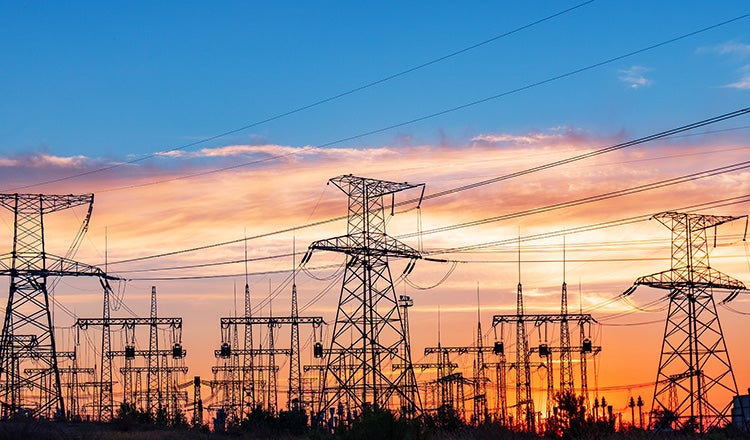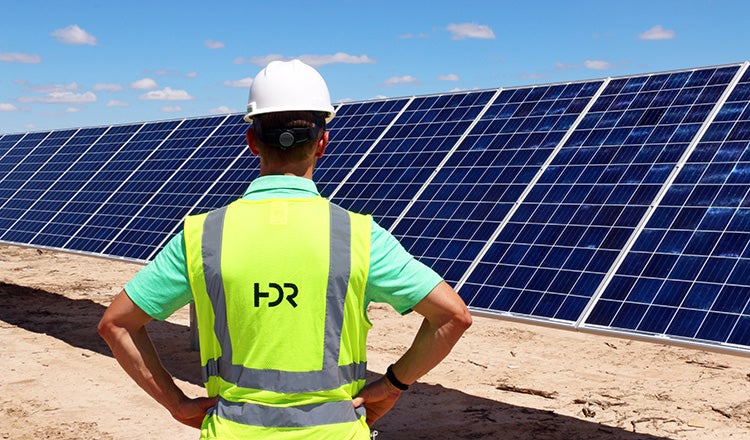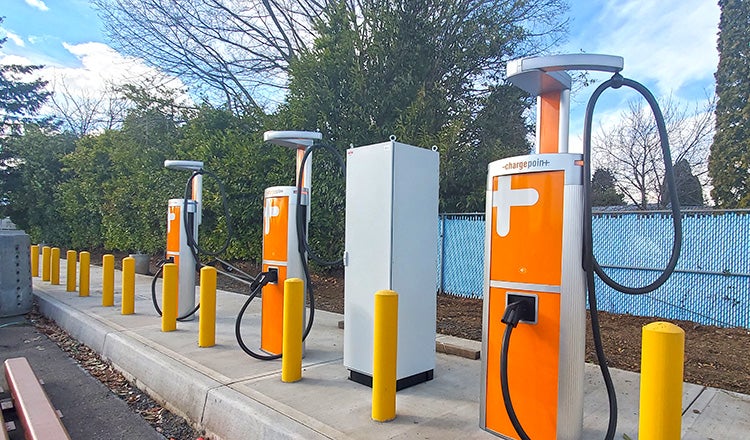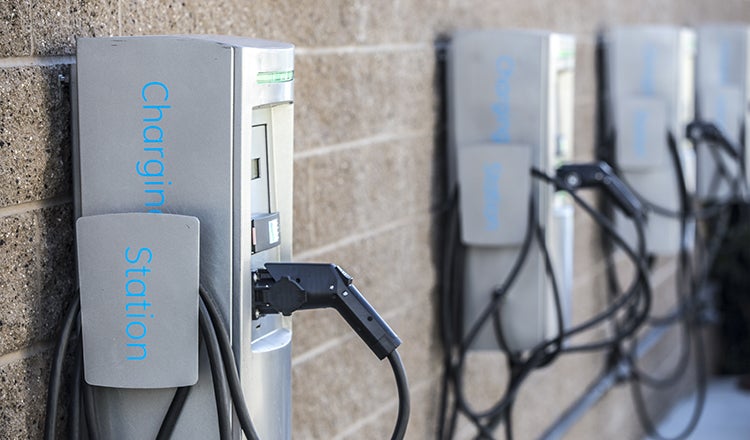
Experts Talk: Rail and Intermodal Facility Electrification With Will Kirby
Experts Talk is an interview series with technical leaders from across our transportation program.
How to Prepare for Decarbonization Solutions at Intermodal and Rail Facilities
Using zero-emission electricity rather than fossil-fuel-based electricity to power buildings, electric vehicles, and facility fleets can significantly reduce a rail facility’s carbon footprint. But it’s not as easy as flipping a switch. Transitioning an intermodal facility or other support asset to green energy involves infrastructure changes that require time and planning to properly implement. As market forces push freight and passenger railroads to decarbonize, the most practical and cost-effective solutions will require careful planning well in advance of target carbon reduction dates. This is a new area for rail operators and owners, who can take lessons from other industries about how to approach electrification.
Will Kirby, P.E., ENV SP, is a transportation sustainability leader in our freight rail group, with a background in renewable energy and power transmission. In his 15 years in the infrastructure industry, he has helped many transportation and power clients successfully adopt practical sustainable solutions for electrification. Kirby is a frequent presenter at sustainability and rail conferences, including the 2023 Federal Rail Administration Rail Decarbonization Workshop and the AREMA 2023 Annual Conference.
Q. What should owners know as they look at electrification as part of their carbon reduction journey?
A. Customers, stakeholders, and market forces are pushing the rail industry toward decarbonization, and owners can start by clarifying the purpose and goals of electrification in their facilities. This could be to reduce emissions, improve local air quality, take advantage of new technology, install more reliable equipment, obtain federal funding, or respond to market pressures. Once the purpose is clear and goals are set, decisions will flow from those overarching goals. For example, if a goal is to reduce emissions but the local utility does not use clean energy, that might lead to a decision to incorporate on-site solar generation at a facility.
Whatever the goal, the process will likely require a major upgrade of a facility’s equipment. When facilities transition from diesel and other fossil fuels, electricity use may increase dramatically — significantly enough, in some cases, to require a new on-site substation. This is a considerable investment, not only in cost and space, but also in time and coordination with the utility. Once the new electricity supply is available, construction of site power distribution at existing sites can cause additional disruptions to the facility itself.
The overall energy transition and subsequent impacts are compounded by utility rates, facility functions, union requirements, fleet size, and more. For example, the layout of charging infrastructure can be driven by operations. Projects meant to be supported by on-site clean energy could trigger additional site work as well to meet interconnection or distribution needs.
Planning and modelling facility schedules, site configurations, and power demand planning can help owners identify which technologies are most compatible with their operations. Modelling can help define an electrification roadmap for pilot projects, which helps further define and refine the course for overall electrification and decarbonization goals, initiatives, and commitments.

Q. How should facilities approach the increased power needs of electrification?
A. Power demand can be a major concern and potential barrier to an electrification transition. Depending on the facility functions, power demand could increase significantly — two or even 10 times more than previous demand. A local utility might not be equipped to immediately support that level of power demand required. Nonetheless, it is critical to engage the local utility early in the process.
There are several options that may help reduce grid power demand amounts based on the needs and capabilities of the facility. On-site solar energy production can be used in some locations, namely on rooftops. Wind energy generally is less desirable due to obstructions, zoning requirements, and other restrictions.
Ultimately, though, the decision will likely involve early-and-often coordination with utility providers in the planning stages of the project. In some cases, if the utility doesn’t have enough grid capacity for the changes, a new transmission line and/or substation might be required — a major undertaking and cost that could get passed along to the rail owner/operator. These barriers to execution should be explored early in the process to ensure that the power will be available when it’s needed.

Q. With a large increase in power demand, how can electrified facilities optimize their energy use?
A. Electrification is a complex undertaking that requires a deep understanding of a facility’s energy profile including power needs, power generation and operational schedules. Once we have information about those needs and constraints, we can use a modelling process to explore the solutions available such as adding a renewable energy source and demand management. This will show us how proposed scenarios can address a facility’s specific operational constraints to meet new power demands.
Modelling a new electrified facility’s operation could, for example, lead to an optimized charging schedule for trucks, or it could reveal a better battery size to use with solar power generation. The modelling process will answer key questions and show the short-term and long-term costs of projects.
Facility modelling can also develop a demand management plan, which can coordinate the power needs of electric infrastructure to reduce peak loads and save on demand costs charged by utilities. It’s also critical to emphasize energy efficiency for the design of new or existing facilities before looking at putting more generation or storage in place.

Q. How can rail facility owners build resiliency into the electrification process?
A. As previously noted, facility owners should start with their overarching goal, this time considering their goals for resiliency. Specifically, how long does the facility need to be able to operate in the event of a utility power outage or power quality issue? Ten minutes? One hour? Two? Four? What equipment, operations, or buildings are critical?
In areas that tend to experience blackouts or brownouts, rail operators may place more value on resiliency or backup systems. In areas with a stable power grid, or when owners have a higher risk tolerance, backup systems may not be as critical.
After determining a site’s resiliency needs, the plan to meet those needs can be developed. It may involve deferred charging or battery energy storage to provide charging for certain equipment, but the owner will still likely need backup generators due to high battery energy storage costs.
Redundant power feeds can also help maintain operations during grid events — if one feed goes down, maybe a separate power feed doesn’t. This could be expensive up front, but it offers another option to enhance resiliency and redundancy.
Q. How can rail owners/operators prepare for rapidly advancing technology?
A. This is a key question in this field. The electrification options and technologies are rapidly expanding. What’s not practicable now could be readily available in just a few years or a decade. Depending on the age and type of equipment or infrastructure, it may even make sense to take a wait and see approach. Battery ranges are increasing for example, which may allow for a reduced amount of charging stations.
Nevertheless, it’s a good idea to prepare plans to transition facilities to be electrification ready, even if there are no immediate plans to move forward with additional electric equipment or energy source. This could be as simple as allotting space for future infrastructure such as chargers or cable trenches.
Owners who are building a new facility but not fully deploying electric equipment can look at projections for power needs if they fully electrify and take them into account when sizing electrical equipment such as circuit breakers and switchgear, many of which have very long lead times. Then this equipment will not need to be retrofitted when the time for electrification arrives. This is also true for safety considerations. For example, facilities may need more fire hydrant coverage for battery installations. This can be done during an ongoing capital project, so the facility is prepared to install the batteries.
With all of this said, the best time to start planning and making preparations is today. Funding is available, so whether you are seeking to initiate a pilot project or a full facility retrofit, it will be prudent to start having the conversations to look toward implementation.

Inspiration and Advice
Q. How did you become interested in the transportation electrification field?
A. The transition to clean energy was a draw for me as well as my interest in general sustainability/decarbonization.
I also saw the transitional challenges the transportation sector was up against in decarbonizing and I certainly wanted to be better prepared and ready to help our clients look at new and creative ways to deliver zero-emission facilities and operational solutions.
Q. What advice do you have for someone just starting out in the electrification field?
A. Be willing to jump in and support however you can. Understand that this is an emerging field, and that patience and relationship building is required to help deliver solutions to some of our trusted clients. It can feel like progress is slow at times even when it seems like everything else is rushing ahead, so I also encourage persistence, patience and a dose of optimism.
Each Experts Talk interview illuminates a different aspect of transportation infrastructure planning, design and delivery. Check back regularly to discover new insights from the specialized experts and thought leaders behind our award-winning, full service consulting practice.




